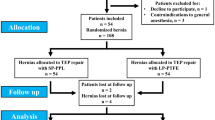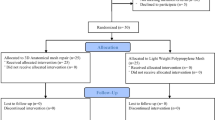Abstract
Objective
We aimed to compare the clinical outcome of titanium-coated mesh and polypropylene mesh in laparoscopic inguinal hernia repair.
Methods
A total of 102 patients who received laparoscopic inguinal hernia repair in January–June 2016 in Beijing Chao-Yang Hospital were enrolled in this study. Patients were randomly divided into two groups, receiving either titanium-coated mesh (n = 50) or standard polypropylene mesh (n = 52). Multiple clinical parameters were collected and analyzed, including clinical manifestations, operative time, intraoperative blood loss, hospital stay, hospital cost, recovery time, and postoperative complications.
Results
All procedures were completed. A statistical difference between two groups was not identified in regards to operative time, intraoperative blood loss, hospital stay, and recovery time (P > 0.05). Three cases with seroma and 15 with foreign body sensation were reported in the titanium-coated mesh group; 9 cases with seroma and 17 with foreign body sensation were reported in the standard polypropylene mesh group. There was no significant difference in the incidence of seroma and/or foreign body sensation. A lower hospital cost but longer recovery period was documented in the standard polypropylene mesh group (P < 0.05). No recurrence, infection or chronic pain was observed during 1-year follow-up in both groups.
Conclusion
Titanium-coated mesh possesses comparable clinical qualities as the standard polypropylene mesh but with a shorter recovery period. Therefore, this mesh is promising for clinical practice though the cost is higher than the standard polypropylene mesh.
Similar content being viewed by others
References
Jakhmola CK, Kumar A (2015) Laparoscopic inguinal hernia repair in the armed forces: a 5-year single centre study. Med J Armed Forces India 71(4):317–323
Burcharth J, Pedersen M, Bisgaard T et al (2013) Nationwide prevalence of groin hernia repair. PLoS One 8(1):e54367
Nathan JD, Pappas TN (2003) Inguinal hernia: an old condition with new solutions. Ann Surg 238(6 Suppl):S148–S157
Feng B, He ZR, Li JW et al (2013) Feasibility of incremental laparoscopic inguinal hernia repair development in China: an 11-year experience. J Am Coll Surg 216(2):258–265
Simons MP, Aufenacker T, Baynielsen M et al (2014) European Hernia Society guidelines on the treatment of inguinal hernia in adult patients. Hernia J Hernias Abdom Wall Surg 13(4):151–163
Koch A, Bringman S, Myrelid P et al (2008) Randomized clinical trial of groin hernia repair with titanium-coated lightweight mesh compared with standard polypropylene mesh. Br J Surg 95(10):1226
Moreno-Egea A, Carrillo-Alcaraz A, Soria-Aledo V (2013) Randomized clinical trial of laparoscopic hernia repair comparing titanium-coated lightweight mesh and medium-weight composite mesh. Surg Endosc 27(1):231–239
SchugPaß C, Tamme C, Tannapfel A et al (2006) A lightweight polypropylene mesh (TiMesh) for laparoscopic intraperitoneal repair of abdominal wall hernias. Surg Endosc 20(3):402–409
Ward CL, Shaw D, Sprumont D et al (2018) Good collaborative practice: reforming capacity building governance of international health research partnerships. Global Health 14(1):1
Klinge U, Klosterhalfen B (2012) Modified classification of surgical meshes for hernia repair based on the analyses of 1,000 explanted meshes. Hernia 16(3):251–258
Tollens T, Topal H, Lucardie A et al (2016) Long-Term Outcome After Laparoscopic Repair of Primary, Unilateral Inguinal Hernia Using a Self-Adhering Mesh. Surg Technol Int 30:151–154
Lichtenstein IL, Shulman AG, Amid PK et al (1989) The tension-free hernioplasty. Am J Surg 157(2):188–193
Pokorny H, Klingler AT, Fortelny R et al. (2008) Recurrence and complications after laparoscopic versus open inguinal hernia repair: results of a prospective randomized multicenter trial. Hernia J Hernias Abdom Wall Surg 12(4):385
Saber A, Hokkam EN, Ellabban GM (2015) Laparoscopic transabdominal preperitoneal approach for recurrent inguinal hernia: a randomized trial. J Minimal Access Surg 11(2):123
Mccormack K, Wake BL, Fraser C et al (2005) Transabdominal pre-peritoneal (TAPP) versus totally extraperitoneal (TEP) laparoscopic techniques for inguinal hernia repair: a systematic review. Hernia J Hernias Abdom Wall Surg 9(2):109–114
Nienhuijs S, Staal E, Strobbe L et al (2007) Chronic pain after mesh repair of inguinal hernia: a systematic review. Am J Surg 194(3):394–400
Li J, Ji Z, Cheng T (2012) Lightweight versus heavyweight in inguinal hernia repair: a meta-analysis. Hernia 16(5):529–539
Bracale U, Melillo P, Pignata G et al (2012) Which is the best laparoscopic approach for inguinal hernia repair: TEP or TAPP? A systematic review of the literature with a network meta-analysis. Surg Endosc 26(12):3355–3366
Sajid MS, Leaver C, Baig MK et al (2012) Systematic review and meta-analysis of the use of lightweight versus heavyweight mesh in open inguinal hernia repair. Br J Surg 99(1):29–37
Brown CN, Finch JG (2010) Which mesh for hernia repair? Ann R Coll Surg Engl 92(4):272
Köckerling F, Schug-Pass C (2014) What do we know about titanized polypropylene meshes? An evidence-based review of the literature. Hernia J Hernias Abdom Wall Surg 18(4):445–457
Ruiz-Jasbon F, Norrby J, Ivarsson M-L et al. (2014) Inguinal hernia repair using a synthetic long-term resorbable mesh: results from a 3-year prospective safety and performance study. Hernia 18(5):723–730
Author information
Authors and Affiliations
Corresponding author
Ethics declarations
Conflict of interest
The authors declare that there is no conflict of interest involved.
Ethical approval
This study was approved by the Ethical Committee of the Beijing Chao-Yang hospital.
Human and animal rights
All procedures were approved by the Institutional Review Board of Beijing Chao-Yang Hospital.
Informed consent
Written informed consents were obtained from all the participants before the trial.
Rights and permissions
About this article
Cite this article
Yang, S., Shen, YM., Wang, MG. et al. Titanium-coated mesh versus standard polypropylene mesh in laparoscopic inguinal hernia repair: a prospective, randomized, controlled clinical trial. Hernia 23, 255–259 (2019). https://doi.org/10.1007/s10029-018-1823-z
Received:
Accepted:
Published:
Issue Date:
DOI: https://doi.org/10.1007/s10029-018-1823-z




